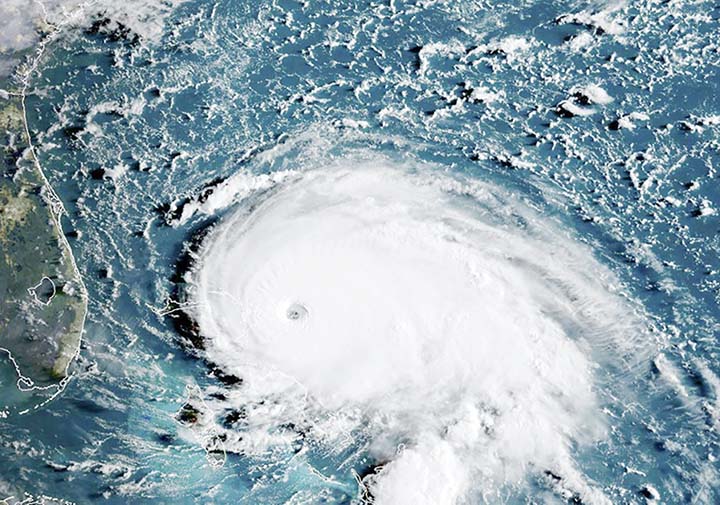
AFP :
Hurricane Dorian battered the Bahamas with ferocious wind and rain on Sunday, the monstrous Category 5 storm wrecking towns and homes as it churned on an uncertain path toward the US coast where hundreds of thousands were ordered to evacuate.
There was no immediate word on casualties in the low-lying islands.
But the International Federation of Red Cross and Red Crescent Societies (IFRC) called the storm’s impact “catastrophic”.
Packing sustained winds of 165 miles per hour (270 kph) with a towering 18 to 23 foot (5 to 7 metre) storm surge, Dorian crashed over the Abacos Islands, in the northwest Bahamas, as the strongest storm ever to hit the Caribbean chain.
It was tied for the second most powerful hurricane ever in the Atlantic basin, the US National Weather Service said-with footage on social media showing major destruction from howling gusts of wind and pounding seawater.
Video posted on the website of the Bahamian newspaper Tribune 242 showed water up to the roofs of wooden houses in what appeared to be a coastal town. Capsized boats floated in muddy brown water dotted with wooden boards, tree branches and other debris.
After days of nerve-wracking uncertainty surrounding the storm’s path, the southeastern US states of Florida, Georgia and South Carolina finally ordered hundreds of thousands of coastal residents to evacuate.
The National Hurricane Center (NHC) said the storm will be “dangerously close” to the Florida coast Monday night through Tuesday.
On Sunday night, the eastern part of Grand Bahama was experiencing the eye wall of the storm. The NHC said the situation on that island was life-threatening and would only worsen overnight.
“Do not venture out into the eye, as winds will suddenly increase after the eye passes,” the NHC warned in its 0500 GMT update.
Bahamas Prime Minister Hubert Minnis broke down in tears at a news conference, calling it “probably the most sad and worst day of my life,” the Nassau Guardian reported.
“We’re facing a hurricane… one that we’ve never seen in the history of the Bahamas,” he said.
As of 0600 GMT, the storm was 35 miles (50 kilometers) east of Freeport on Grand Bahama and moving slowly west, according to the NHC.
“It feels like we are standing in a line waiting for a beating,” Yasmin Rigby, a resident of Freeport, the island’s main city, told AFP.
Initial rapid emergency assessments, carried out by the IFRC and local authorities, said as many as 13,000 buildings may have been damaged or destroyed by Dorian.
Sune Bulow, head of the IFRC Emergency Operations Centre in Geneva, said: “We don’t yet have a complete picture of what has happened. But it is clear that Hurricane Dorian has had a catastrophic impact.”
NHC director Ken Graham said the Bahamas would be under major hurricane conditions for a punishing 30 hours or more-enduring roaring winds and torrential rainfall of 15 to 20 inches, even 30 inches in places.
In Washington, President Donald Trump met with his emergency management chiefs and declared “this looks monstrous.”
“We expect that much of the eastern seaboard will be ultimately impacted and some of it very, very severely,” he said.
Florida issued its first evacuation orders in parts of Palm Beach, home of Trump’s Mar-a-Lago resort, and Martin Counties.
South Carolina Governor Henry McMaster followed suit Sunday ordering mandatory evacuations of the state’s coast-affecting some 800,000 people-while Georgia gave orders to evacuate six coastal counties. Both orders take effect Monday at noon.
“Given the strength and unpredictability of the storm, we must prepare for every possible scenario,” McMaster said.
Neighboring North Carolina has also declared a state of emergency.
Kevin McAleenan, acting homeland security secretary, said hurricane-force winds could hit Florida, followed by a prolonged rain event combined with a storm surge.
“That’s going to be very difficult as the storm starts to move northward,” he said on ABC’s “This Week.”
Trump has declared a federal state of emergency in Florida, authorizing US assistance to supplement state and local efforts.
In southern Florida’s Jensen Beach, a mobile home park visited by AFP stood all but empty-its rickety dwellings boarded up with thin wood or metal sheets.
Joe Lewis, a 61-year-old navy veteran-who is diabetic and disabled-was trying to prop up his air conditioner with a wooden post as he prepared to flee the storm’s path.
“When I come back, this place may not be here,” he told AFP. “Mother Nature can be hell. I’ve seen it.”
“There’s only one thing that’s important. It’s not what you own, it’s who you are, and your life. It doesn’t matter if I’ve got a million-dollar home, I leave it. My life’s more important.”

